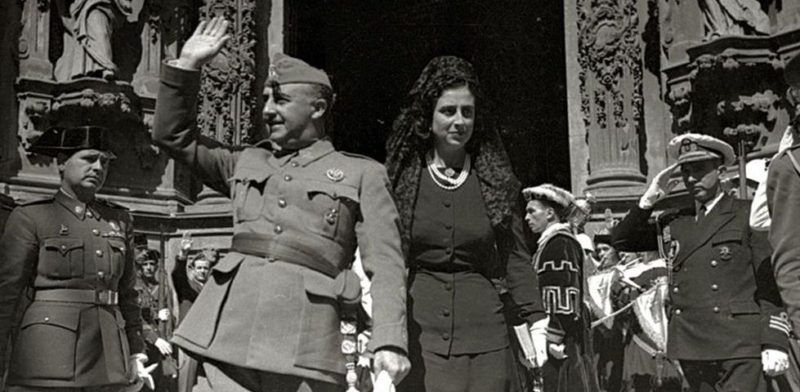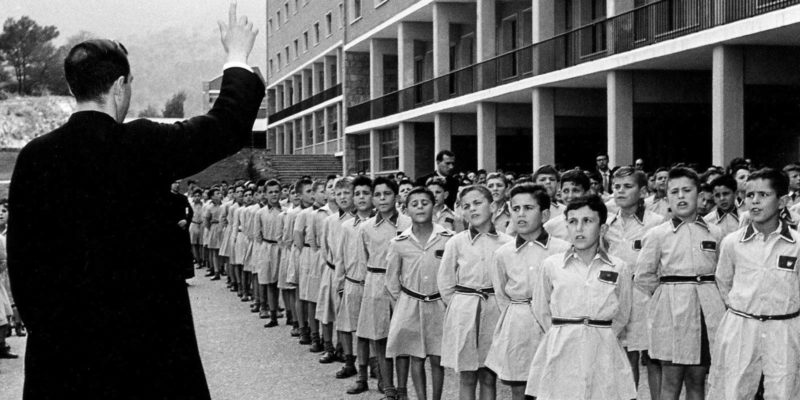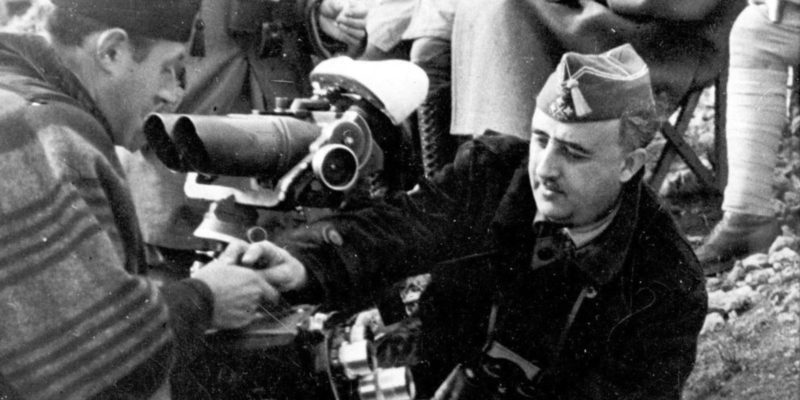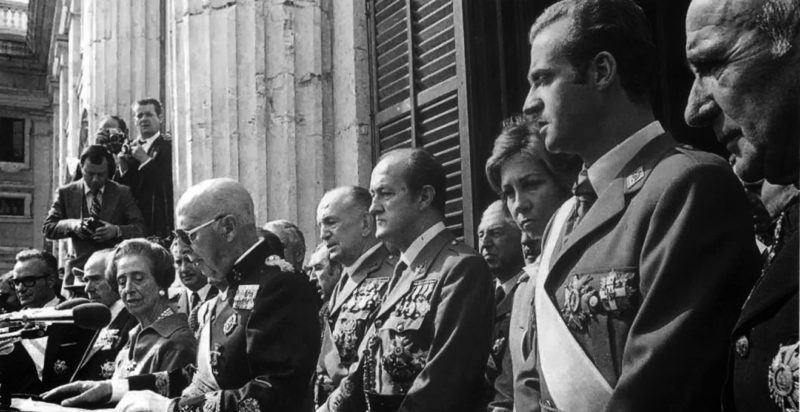We explain what Francoism is, the objectives of this authoritarian regime, and its general characteristics. Stages and end of Francoism.
What was Francoism?
Francoism was a historical movement of an authoritarian nature ( government de facto ) led by Colonel Francisco Franco , which took place in Spain from 1939, after the Spanish civil war , until 1975 with Franco's death.
It was a totalitarian dictatorship in which Franco governed with all the powers of the State and dictated fundamental laws . He strongly opposed left-wing ideologies, with the aim of preventing communism from advancing towards Spain and the rest of Western Europe .
It was characterized as an ultra-Nationalist, Catholic and militarist movement that carried out measures such as censorship of the media , the elimination of opposition parties and the creation of a single party: the National Movement. It also banned labor unions and co-official languages such as Catalan and Basque.
Franco assumed power after defeating the Republicans in the Civil War. Because he was in command of Spain for almost 40 years, his government had different stages that varied according to the internal and world context. The Franco regime ended when the general died on November 20, 1975.
Origin and emergence of Francoism

Francisco Franco Bahamonde had a military career and from his first years of exercise he stood out in the war in Morocco, a conflict in which he participated for more than fourteen years between 1912 and 1926. Due to his discipline and tactics in war he was given the position Brigadier General at the age of 33 , which earned him great prestige within the army.
After his return to Spain, Franco was appointed leader of the Military School of Zaragoza and then he was given the Head of the General Staff. In 1934 he was in charge of containing the Asturias Revolution , a strike carried out by socialist groups. In 1936 the Popular Front (a coalition of left-wing parties) won the elections and, fearing that it might become involved in a possible military coup, Franco was sent to the Balearic Islands.
A coup d'état to overthrow the leftist government was conceived in the ranks of the army and General Franco was reluctant, so he did not accompany from Spain but from Africa .
The coup against the Second Republic (which was called “National Uprising”) took place in July 1936 and, although it failed in many of the main Spanish cities , it started the Civil War. In the Spanish Civil War, the Republican side (made up of Republicans and left-wing parties, popular forces and part of the army) clashed against the rebel side, which proclaimed itself the "national side".
On the national side, the military man José Sanjurjo was proposed as leader of the uprising, but on July 20, 1936 he died in a plane crash and, after his death, Franco was offered the position of generalissimo. After the siege of the Alcázar of Toledo, he was also granted the position of Head of State (although there was still territory in the hands of the Republican side).
From there, Franco established a war plan to confront the Republican side and had the support of German and Italian troops. For the next three years he stalked Republicans and leftists, who were aided by the Soviet nation. At the same time, Franco began a prestige campaign through the media and proclaimed himself Caudillo of Spain.
The successive frustrated attempts of the national side to take Madrid meant greater foreign aid. The battle of Guadalajara, one of the biggest failures of the nationalist side, and the bombing of Guernica, an attack against the rights and lives of innocents that earned the national side worldwide repudiation, were some of the main milestones of this war.
With the fall of the last cities, Barcelona, Madrid and Valencia, on April 1, 1939, the national side led by Francisco Franco was victorious . Already in command of the only political party and the army, Franco established a personalist government throughout Spain.
Characteristics of Franco

Some of the main characteristics of Francisco Franco's government were:
- Authoritarianism . All the power, control and execution of what happened in Spanish territory was under the command of the figure of Franco. It had executive and legislative powers, for this reason, its power was totalitarian.
- Anticommunism . The main objective of the Franco government was that communism did not reach Spain. Under the slogan "Sentinel of the West", which was used during the Franco regime to refer to Spain, the displeasure with leftist ideologies, which the regime steadfastly opposed, was made visible.
- Unipartism . During the Civil War, the national movement was created, also called FET de las JONS (Spanish Traditionalist Falange of the National Syndicalist Offensive Boards), which was the only official political party and allowed during the Franco regime. In this way, the rest of the political parties that tried to propagate a political doctrine were considered illegal and had to carry out their campaigns clandestinely.
- Militarism . During the Franco regime, the army was one of the main and most important groups of power. Many of Franco's collaborators came from the army and were the owners of political power by directing the main state organizations.
- Suppression . During the Franco regime, all those who were considered to be on the Republican side were persecuted, for which many had to go into exile from Spain. The left and the Catalan and Basque nationalists were persecuted.
- Ultra-Catholicism . Catholicism took command of student and political affairs and became the religion par excellence. Franco considered himself an envoy from God to save Spain.
- Ultranationalism . During the Franco regime there was an exaltation of the homeland and of the figure of Spain, with symbols that characterized the regime, such as the use of a blue shirt, uniform and red beret, hymns, among others.
- corporatism . Corporatism in Spain was founded in 1933 and had remarkably similar principles to those of Italian fascism.
- Censorship . The press, radio and television were controlled by military command. By having control of the mass media, an attempt was made to regulate public opinion by suppressing any attempt at revolution or thought against the regime. In addition, opposition parties and unions and co-official languages such as Catalan and Basque were suppressed.
- Slogans and Propaganda . The government and the media tried to instill and highlight religious and nationalist values, promoting the unity, greatness and independence of Spain. This could be seen in a slogan of the time: “Spain one, great and free”.
Francoism stages

Franco's government can be studied from four main stages:
- The first stage (1939-1953): Years of isolation and poverty
At the end of the war , the United Nations (UN) was created, but Spain was excluded due to Franco's relationship with fascism . This period was known as the period of isolationism, because many countries closed their borders and diplomatic relations with Spain.
- Second stage (1953-1959): End of the period of foreign isolation
The Cold War favored Spain, because it placed this country within the anti-communist countries and this brought it closer to Western countries. With a renewed government and the arrival of the technocrats, Spain entered a new economic phase in which the first economic treaties were signed with foreign ambassadors, which fostered economic growth.
In 1955 Spain entered the UN and received military and technological aid from foreign countries. With the end of foreign isolation Spain was opened to economic development , tourism and immigration.
- Third stage (1959-1969): Period of economic development
Despite the fact that the regime was authoritarian and that all political expressions that were not framed under the "La Falange" party were prohibited, during this period the first opposition demonstrations began to emerge, which were also seen in other countries that did not give the thumbs up to the regime.
Economic and social stability came hand in hand with the stabilization plan in 1959, but politically the same did not happen. The middle class raised its income and its status of life improved , although all this happened 20 years later than in the rest of Western Europe.
- Fourth stage (1969-1975): Agony of Francoism
With the beginning of the 1970s, strikes and protests increased and the political opposition grew stronger , to the detriment of Franco's health, which showed a profound deterioration. The pressure due to his illness made Franco appoint Juan Carlos I as his successor.
The Franco regime came to an end on November 20, 1975 with the death of Francisco Franco.
End of Francoism

At the beginning of the 1970s, social unrest regarding the Franco regime, added to international condemnation for the crimes and abuses committed in the last four decades, began to crack the power of Francoism. Added to this were the health problems that afflicted the leader , mainly Parkinson's disease.
In his first years of government, Franco had promised Juan de Borbón (son of Alfonso XIII and direct heir to the throne) to restore the Spanish monarchy. Some time later, in 1969, and seeing the end of Francoism near, Franco proposed the throne to Juan Carlos (son of Juan) , with whom he had a close relationship since he was 10 years old.
Thus, on November 20, 1975, when Francisco Franco died, King Juan Carlos I assumed power.
The above content published at Collaborative Research Group is for informational and educational purposes only and has been developed by referring reliable sources and recommendations from technology experts. We do not have any contact with official entities nor do we intend to replace the information that they emit.
MA student of the TransAtlantic Masters program at UNC-Chapel Hill. Political Science with a focus on European Studies. Expressed ideas are open to revision. He not only covers Technical articles but also has skills in the fields of SEO, graphics, web development and coding. .
Leave a reply
Your email address will not be published. Required fields are marked *Recent post

Sport: What Is It, Types, Risks, Features, Characteristics and Examples

Dogs: Emergence, Features, Characteristics, Feeding and Breeds

Story: Definition, Elements, Structure, Features and Characteristics

